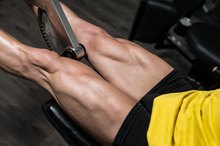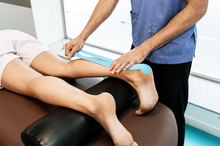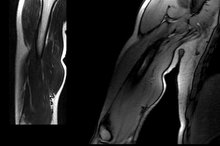How to Tell If Your Hamstring Is Strained or Pulled
Pulls and strains mean the same thing — you've damaged a muscle. Whether it was from running, lifting weights or a simple everyday activity, you'll know if you strained your hamstring. There are three levels of muscle pulls, each with a different amount of severity. The challenge is determining how severe the injury it is because that will change how it's treated.
Muscles are made up of bundles of incredibly resilient tissue. Despite how tough it might be, there's always a chance that the muscle gets pushed too far and you end up with an injury.
One of the most common muscle injuries is a muscle strain, which is the medical term for the injury. However, it's more commonly known as a pulled muscle.
Read More: How to Heal a Muscle Strain
How Hamstrings Get Strained
Unfortunately, the hamstrings are particularly vulnerable to muscle strains. They're long muscles that run from the bottom of your hip bone, down the back of your leg and connect to the top of your shin bone. These muscles are active in running and sprinting and help push your leg back and bend your knee, things you do during every stride when you walk or run.
The most common way to strain a muscle is to put too much strain on it while it lengthens.
The tension plus stretching creates a lot of force on your muscle fibers that causes them to split. During running, and especially sprinting, you constantly flex the hamstring as you lengthen it.
When you push off of your back leg when running or sprinting, your hamstring is lengthening as you push.
That's because your knee is straightening out behind you, stretching your hamstring. As you push off you put a lot of strain on the muscle, creating the perfect storm for a pulled hamstring.
- Unfortunately, the hamstrings are particularly vulnerable to muscle strains.
- When you push off of your back leg when running or sprinting, your hamstring is lengthening as you push.
Muscle Strain Symptoms
Quadricep Pain While Sprinting
Learn More
If you actually experience a strain, the first thing that you'll probably hear or feel is a pop. That's the muscle giving way under too much tension. You're also going to feel a sharp pain coming from the back of your leg very quickly after you hear or see the pop.
Grades of Strains
After the injury, you might notice some swelling and bruising in the area.
It may also be difficult to walk on the injured leg because the hamstring will be weak. From there, diagnosis gets a little more in-depth because there are three different grades of muscle strains.
- Grade 1. The first grade of muscle strain is the least serious. You'll feel some pain in the area but you'll still be able to walk around. There will be mild bruising, if any, and your range of motion won't be any more limited than it was prior to the injury.
- Grade 2. Slightly more serious, a grade 2 sprain means that the muscle is fairly damaged but not completely torn. There will be bruising, you'll be limping and you won't have as much range of motion as before. You're looking at a longer recovery time, up to two to three months long. * Grade 3. This is the most serious form of muscle strain or pull. At this point, the muscle is almost completely torn. Walking will be a challenge, and the muscle will have almost no strength. At this point, surgery may be required for you to get back to working out.
Read More: How to Tell If You Pulled a Muscle
- After the injury, you might notice some swelling and bruising in the area.
- There will be mild bruising, if any, and your range of motion won't be any more limited than it was prior to the injury. * Grade 2.
What to Do About Muscle Strains
The Pain in My Right Calf Hurts More When I Squat
Learn More
No matter what form of strain you think you have, the best course of action is to see a doctor.
They can properly diagnose what level of strain you have, if any. Sometimes a lower back injury can cause pain in your hamstrings, so it's important to rule out that as well.
In addition to seeing a doctor, make sure you rest, ice, and elevate the injury immediately. This will help it on the path to healing quickly and prevent you from hurting it any further.
- No matter what form of strain you think you have, the best course of action is to see a doctor.
- Sometimes a lower back injury can cause pain in your hamstrings, so it's important to rule out that as well.
Related Articles
References
- Johns Hopkins: Muscle Strain (Pulled Muscle)
- Hospital for Special Surgery: Muscle Injuries: An Overview
- Physio Works: Hamstring Strain
- OrthoInfo: Hamstring Muscle Injuries
- Ernlund L, Vieira LA. Hamstring injuries: update article. Rev Bras Ortop. 2017;52(4):373-382. doi:10.1016/j.rboe.2017.05.005
- Heiderscheit BC, Sherry MA, Silder A, Chumanov ES, Thelen DG. Hamstring strain injuries: recommendations for diagnosis, rehabilitation, and injury prevention. J Orthop Sports Phys Ther. 2010;40(2):67-81. doi:10.2519/jospt.2010.3047
- Moatshe G, Chahla J, Vap AR, et al. Repair of Proximal Hamstring Tears: A Surgical Technique. Arthrosc Tech. 2017;6(2):e311-e317. doi:10.1016/j.eats.2016.10.004
- Noonan TJ, Garrett WE. Muscle strain injury: diagnosis and treatment. J Am Acad Ortho Surg. Jul 1999;7:262-9.
Writer Bio
Henry is a Philadelphia-based personal trainer and writer. He has trained a wide range of clients, from professional athletes to working professionals. Feel free to contact Henry with any questions regarding an article that he's written.









